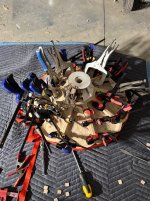I gather all the data that are necessary, i.e. the complex (pseudo-)anechoic FRs (+electrical impedances if passive filters are involved), and then design all the filters in a simulator to achieve the final acoustic responses I like (for all the polars) - there are never any "ideal XO slopes" given in advance. I've never flattened the responses first, but I guess there's no reason you couldn't do it that way, if it works for you.So how do you end up with ideal XO slopes - whats your way of doing it?
But from what I saw, you don't use gated data, so your workflow may be different.
OK! I do use gated input data for EQ. I don't think have shown my actual XO design process.
//
//
Where is the light inside? 😉
Looks like modern art! I think if you put a nice grille before the woofer, it will be even more beautiful.
I'm thinking about it. But my six-month ban from rebuilding speakers isn’t over yet—my wife had enough last time when I turned the living room into a woodworking shop. 😎 Just a couple more months, and I’ll give it a go ))Looks like modern art! I think if you put a nice grille before the woofer, it will be even more beautiful.
Happy to see our group buy is competitive by a large margin.
Bwahahahahaah classic - 6 months is so long to make do with one set of speakers 😀my six-month ban from rebuilding speakers isn’t over yet
Too heavy.
These horns really lend themselves to bubblegum aesthetics, pastel shades, sneaker-style colorways and colors that pop. Plus a minimal wire style holder for the horn painted in black to match with an Eames DSR fiberglass chair. Think: sunshine.
No need to get all gloomy.
These horns really lend themselves to bubblegum aesthetics, pastel shades, sneaker-style colorways and colors that pop. Plus a minimal wire style holder for the horn painted in black to match with an Eames DSR fiberglass chair. Think: sunshine.
No need to get all gloomy.
Too bad you'd need like a 5th axis for it since you'd otherwise make the job very easy cross-drilling holes in the stiffening flanges... would be able to bolt the petals together
Although having said that, next time you could glue tabs to each of the petals that would allow bolting. You don't have to clamp very strongly during glue-up either
Or mill open-end slots so you can drop the bolts through from the top, those you can still do with a 3-axis router
Although having said that, next time you could glue tabs to each of the petals that would allow bolting. You don't have to clamp very strongly during glue-up either
Or mill open-end slots so you can drop the bolts through from the top, those you can still do with a 3-axis router
I printed some petals in PLA and PETG and now that i've worked with both i would say PETG is superior for this application - it's better for sanding and it seems to have a lower resonate frequency. It also seems to have less warping / better geometry.
Less colour choices tho and more difficult to print with vs PLA.
Less colour choices tho and more difficult to print with vs PLA.
It very much depends on the particular filament. I have come across both PETG and PLA that were impossible to print without agony, and vice versa.PETG is superior
Too bad you'd need like a 5th axis for it since you'd otherwise make the job very easy cross-drilling holes in the stiffening flanges... would be able to bolt the petals together
Although having said that, next time you could glue tabs to each of the petals that would allow bolting. You don't have to clamp very strongly during glue-up either
Or mill open-end slots so you can drop the bolts through from the top, those you can still do with a 3-axis router
I sort of did this with a Domino after the fact - routed in two mortises simply for alignment, and it has worked beautifully. I realized during the first glue-up I can't get the mortises in on the last petal if I do all 9 in a row, so I think for the second one I'm going to do a section of 5 and a section of 4, and then glue those two up so I can get the mortises in there. It's not a strength thing as much as it is an alignment thing.
One thing I wish I would have thought of prior is the back recess tapers down to a with of about 1.25" - which makes sanding the recess there a nightmare as I can't get a sander in.
Postman just brought some new toys....

- Home
- Loudspeakers
- Multi-Way
- Acoustic Horn Design – The Easy Way (Ath4)


